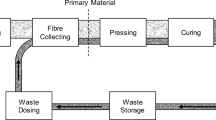Abstract
A major influence on the cost of a product is the time it takes to make this product. Traditional cost accounting can grasp part of this relation, but misses many critical aspects of having a faster time to the customer. Rajan Suri analyzed this relation empirically. Based on a data set with industrial data he determined an empirical mathematical relation between the turnaround time to the customer (or replenishment time) and the product cost for the entire value stream. This paper modifies the approach by Suri to be applied also to segments of the value stream, creating a relation between the cost within of a segment of a value stream and the time it takes for a part to pass through this segment of a value stream. This allows the estimation of the improvement in cost and the reduction in turnaround time also for sub-segments of the value stream, helping decision makers to better understand the impact of their decisions.
Access this chapter
Tax calculation will be finalised at checkout
Purchases are for personal use only
Similar content being viewed by others
Notes
- 1.
These numbers are different because the way percentages work. An increase of 100€ by 12% would get 112€. Decreasing 112€ by 12% would get 98.56€. Decreasing it by 10.7% would give 100€ again.
References
Bhimani A, T. Horngren C, Foster G, Datar S (2012) Management and cost accounting
Ouyang L-Y, Chen C-K, Chang H-C (1999) Lead time and ordering cost reductions in continuous review inventory systems with partial backorders. J Oper Res Soc 50:1272–1279. https://doi.org/10.1057/palgrave.jors.2600840
Chang H-C, Ouyang L-Y, Wu K-S, Ho C-H (2006) Integrated vendor–buyer cooperative inventory models with controllable lead time and ordering cost reduction. Eur J Oper Res 170:481–495. https://doi.org/10.1016/j.ejor.2004.06.029
Chandra C, Grabis J (2008) Inventory management with variable lead-time dependent procurement cost. Omega 36:877–887. https://doi.org/10.1016/j.omega.2006.04.009
Hartley JR (2017) Concurrent engineering: shortening lead times, raising quality, and lowering costs. Routledge
Clark KB, Fujimoto T (1989) Lead time in automobile product development explaining the Japanese advantage. J Eng Tech Manage 6:25–58. https://doi.org/10.1016/0923-4748(89)90013-1
Fujimoto T (1999) The evolution of manufacturing systems at Toyota, 1st edn. Oxford University Press, Oxford, New York
Suri R (1998) Quick response manufacturing: a companywide approach to reducing lead times. Taylor & Francis Inc, Portland, OR
Suri R, de Treville S (1992) Rapid modeling: the use of queueing models to support time-based competitive manufacturing. In: Fandel G, Gulledge TR, Jones A (eds) Operations research in production planning and control. Springer, Hagen, Germany, pp 21–30
Suri R (2014) MCT quick reference guide. Suri Consulting and Seminars, LLC
Suri R (2010) It’s about time: the competitive advantage of quick response manufacturing, 1st edn. Productivity Press, New York
Tubino F, Suri R (2000) What kind of “numbers” can a company expect after implementing quick response manufacturing? Empirical data from several projects on lead time reduction. In: Quick response manufacturing 2000 conference proceedings
Acknowledgements
We would like to thank Rajan Suri for his input.
Author information
Authors and Affiliations
Corresponding author
Editor information
Editors and Affiliations
Rights and permissions
Copyright information
© 2020 Springer Nature Switzerland AG
About this paper
Cite this paper
Roser, C., Langer, B., Deuse, J. (2020). The Power of Six: Relation Between Time and Money in Manufacturing for Segments of the Value Stream. In: Rossi, M., Rossini, M., Terzi, S. (eds) Proceedings of the 6th European Lean Educator Conference. ELEC 2019. Lecture Notes in Networks and Systems, vol 122. Springer, Cham. https://doi.org/10.1007/978-3-030-41429-0_3
Download citation
DOI: https://doi.org/10.1007/978-3-030-41429-0_3
Published:
Publisher Name: Springer, Cham
Print ISBN: 978-3-030-41428-3
Online ISBN: 978-3-030-41429-0
eBook Packages: EngineeringEngineering (R0)




